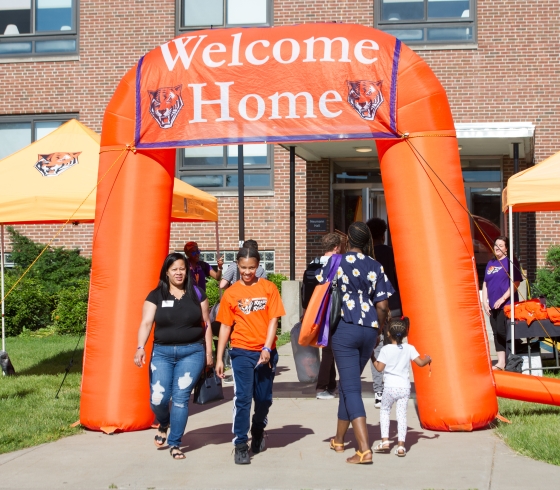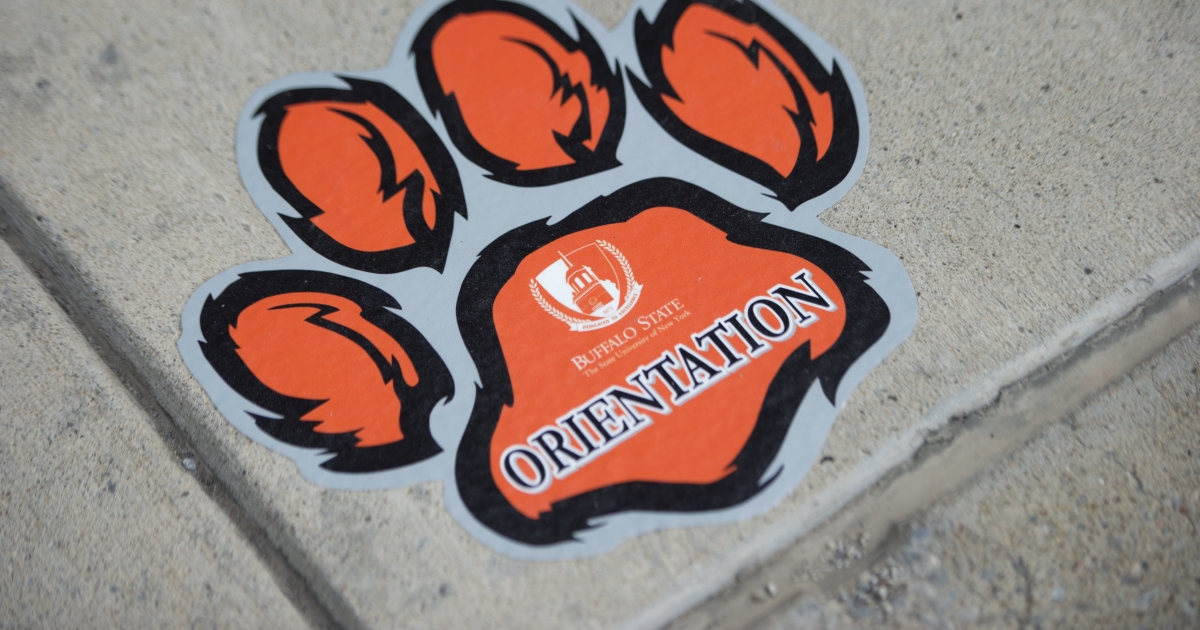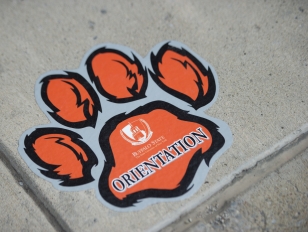
Coming to college is exciting, but—for many students—it can also be overwhelming. Buffalo State University’s Orientation programs are campuswide collaborations that aim to put new students at ease by helping them acclimate to campus, learn about available resources, and become part of the Buffalo State community.
“Orientation programs are the culmination of successful recruitment efforts to enroll new students in their first college-level experience,” said Wayne Brumfield, interim vice president for student affairs. “They provide positive interactions with the university community and expose students and families to excellent activities, which promote well-being and a sense of ‘I belong here.’”
“Orientation is an all-hands-on-deck Buffalo State campus performance,” added Elizabeth Ching-Bush, interim dean of students. “Without that involvement, we could not give students these opportunities. That campus involvement really speaks to the experience a student has.”
Buffalo State offers multiple Orientation programs, including three half-day Transfer Orientation sessions, four sessions of New Student Orientation (NSO), sessions for incoming fall athletes and military and veteran students, and even a “last chance” Orientation, just after move-in day, for anyone who was not able to attend a previous session. Each program is designed with a target student group in mind and provides a host of benefits.
Here are five ways Buffalo State’s Orientation programs set new Bengals up for success:
Orientation Affirms Their Decision to Be Part of the Buffalo State Community
Buffalo State’s Orientation programs are carefully and intentionally curated to maximize student comfort while introducing them to all the university has to offer.
“Having a warm, welcoming environment is one of my main goals,” said Thomas Trzepkowski, associate director of orientation, transition, and family programs. “We want students to feel confident they chose Buffalo State for the right reasons, so they feel excited to come back in August.”
Trzepkowski added that Orientation can open students’ eyes to new opportunities. “A commuter student might spend the night for Orientation and decide later they want to become a resident,” he said. “Or seeing their orientation leader might spark the idea that they want to be one someday.”
Ching-Bush said that Orientation also helps encourage students to get involved and be active in the Buffalo State community.
“In a way that is gentle and not overwhelming, we let them know that—just as they have expectations of us—we have expectations, too,” she said. “Orientation is a chance to say, here’s our community, here’s what the community can give you, and here’s how you can participate in that community and make the most of your time here.”
Orientation Helps Students Acclimate to Campus
There is great value in physically setting foot on campus, spending time in buildings, and becoming familiar with the surrounding area. For many non-local students, this is the first time they’ve had the chance to do so.
“We are in the city of Buffalo,” Trzepkowski said. “No other SUNY institution is like that. Admissions counselors can tell students, ‘It’s in the heart of the Elmwood Village,’ but what does that mean to them? They need to see it.”
Beyond traditional campus tours, Orientation offers students the chance to explore, spend time in academic buildings, and—during NSO—spend the night in a residence hall.
“Getting on campus and smelling the flowers, seeing the greenery, and stepping into the residence halls changes your perspective of what it actually will be like to be here,” Ching-Bush said. “Instead of imagining it, you’re experiencing it.”
This year—for the first time—students that attend NSO will meet with academic advisors and receive fall schedules, another important step toward feeling comfortable and confident with where they’ll be going during the first week of classes.
Orientation Introduces Important Resources
An essential element of all Buffalo State’s Orientation programs are information sessions on the university’s plentiful student resources.
“We want students to know what resources and opportunities are available to them,” Trzepkowski said.
During Orientation, students can learn about not only their own academic departments but also student life, counseling services, Financial Aid and Student Accounts, Student Conduct and Community Standards, career services, the University Police Department, Title IX services, study-abroad opportunities, tutoring, athletics, and the Weigel Health Center. Additionally, the Civic and Community Engagement Office offers service-learning opportunities during Orientation and helps new students register to vote.
During NSO, students also participate in a story-based learning workshop with the Anne Frank Project and can “choose their own adventure,” by opting to attend panels on residence life, commuting, LGBTQ+ resources, and United Students Government (USG).
“Orientation is an opportunity to enhance awareness of what we are able to provide for students, parents, and families,” Ching-Bush said. “If you look at the context and demographics of our students, there’s a need we want to support. Especially with first-generation students and parents, there’s a lot of ‘I don’t know what I don’t know.’ We want to fill in those blanks.”

New this year, in collaboration with Shawnte Wilson and the Roar 2 Success program, NSO will offer the “First-Year Success Presentation.” Orientation leaders will act out common scenarios, such as roommate conflict, and Wilson or Trzepkowski will “pause” the skit to facilitate discussion and offer solutions.
Orientation Facilitates Peer Interaction—and Fun!
Orientation is a lot of information—but it’s also a time for students to socialize and enjoy themselves. Students and families bid farewell after the welcome on Day One (parents and families participate in their own concurrent Orientation program) and are not reunited until Day Two. Trzepkowski said this encourages students to interact and bond with peers.
“We want the students to be students and have fun,” he said. “Sometimes when parents and families are around, they don’t do that.”
“The tangible experience of learning how to communicate and interact with one another, the opportunity to step outside of your comfort zone and not hide—these are things we are constantly teaching our students,” Ching-Bush added. “We want them be their authentic selves as much as possible.”
Orientation offers an abundance of opportunities for socializing, including dividing students into small groups led by Orientation leaders (all of whom are current Buffalo State students who act as peer mentors), group meals, and “Bengals after Dark”: evening programming featuring a dance party, pizza, paint and sip, an open mic, and more.
“They don’t have a curfew,” Trzepkowski said. “We make sure everyone’s safe, but they can hang out with their friends.”
Orientation Assures Students That Buffalo State Is Here for Them
Buffalo State is committed to providing all students with an Orientation experience that gives them what they need for their future at Buffalo State.
For example, because fall athletes are required to move in early to begin practice, Buffalo State’s Orientation for incoming athletes is held in mid-August, so that out-of-state families aren’t required to make multiple trips.
“In everything we do, we look at all the opportunities we’re trying to create for students and make sure every student has that opportunity in the same way,” Ching-Bush said. “We want to show them who is here to support them—the entire Buffalo State community. Every person will walk away with something different, and we hope that’s something positive.”
“Buffalo State is going to be their home for the next four years,” Trzepkowski added. “We want to make sure they know they made the right decision.”
Photos by Buffalo State Marketing and Communications.



